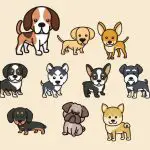Newfoundland
Description:
The Newfoundland or Newf is one of the giant dog breeds whose soft expression and teddy bear appearance gives an indication of what a wonderful family dog it is. The Newf is gentle giant who weighs in at 120 to 160 pounds and stands 26 to 28 inches tall at shoulder height. Newfs have a thick and dense double coat. The Newf’s outer coat is coarse, straight and lies fairly flat with an oily, water resistant texture. The under coat is soft and dense. The coat may be slightly wavy but not curly. Colors are black or brown but there is a variety known as the “Landseer” which is white with black markings. Newfoundlands are members of the American Kennel Club (AKC) Working Dog Group.
History:
The ancestors of this giant breed are unknown. Some experts claim that the Vikings brought its forebears to Newfoundland. Other experts claim that it is descended from Tibetan Mastiffs and yet others say it is a descendant of the Pyrenean Mountain Dog brought to Newfoundland by Basque fishermen. Whatever its origins, the Newf developed as a sea rescue dog that carried lifelines to sinking ships and also helped pull in fishermen’s nets and haul carts. Newfoundlands also became popular in England and France during the 18th century and were also popular with sailors as ship dogs. Today the Newfoundland is popular as a family dog. This breed was ranked 45th out of 154 dog breeds in 2004 AKC registrations.
Temperament:
The Newfoundland has a wonderfully sweet and gentle disposition that is reflected in his kind expression. This gentle and good-natured giant dog is great with children and makes a terrific family dog. Toddlers should be supervised carefully as one slurp from his big tongue could knock a little one over. Newfs are quite intelligent and can be trained fairly easily using praise and food rewards. Newfs and all giant breeds should be socialized and obedience trained early while puppies and through adolescence. All giant breeds must be well trained. Male Newfoundlands can be a little more independent than females. Newfs need lots of companionship and need to be involved in family activities. Some Newfs are shy but generally get along very well with strangers. Newfoundlands are suitable for novice or first-time owners.
Exercise:
Newfoundlands need lots of living space and do very well in a country setting. However they should not be left alone in a yard for long periods of time as they need companionship. Newfs should have a fair amount of exercise until about the age of two when they will become more placid. Don’t exercise these dogs too vigorously while they are growing. Swimming is an ideal exercise. This dog was born to swim as is evident in its webbed feet, and should be given lots of opportunities to get in the water. Newfs pant a lot, drink lots of water and are major-league droolers.
Grooming:
This breed needs lots of grooming – so brush and comb the Newfs regularly and pay special attention to its hindquarters and other densely feathered areas where tangles can form. Trim and remove excess hair between the pads of the feet and inside their ears.
Health Considerations:
Newfoundlands can be expected to live about 10 years. Newfs have some common health problems of which hip dysplasia and heart disease are the most serious. Less common conditions include: elbow dysplasia, cataracts and eyelid abnormalities (both ectropion and entropion). When buying a Newf, you should ask to see both the parent’s OFA (Orthopedic Foundation for Animals) certificates for hips and elbows and the recent CERF (Canine Eye Registry) results for eyes. Newfs like shade and can suffer heat-stroke in very hot and humid conditions.
Article type: xdogbreed


